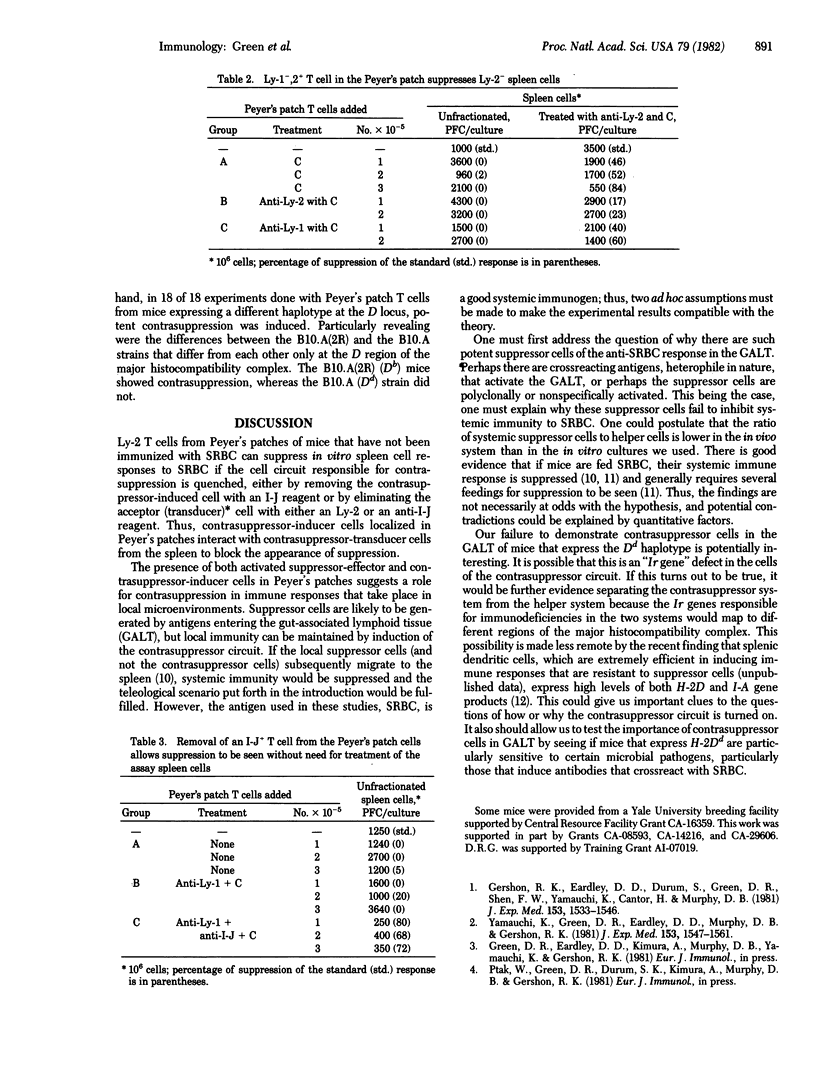Abstract
The addition of Peyer's patch T cells from most strains of mice to spleen cells in primary Mishell-Dutton cultures either has no effect or augments the spleen cells' response to sheep erythrocytes. However, if the Peyer's patch T cells are treated with an anti-I-J antiserum and complement to remove contrasuppressor-inducer cells, the remaining Ly-2 cells (T cells that express Ly-2 but not Ly-1) are highly suppressive. This "latent" suppressor cell activity also can be revealed by removing contrasuppressor-acceptor (transducer) cells from the splenic assay population with either an anti-I-J or anti-Ly-2 antiserum. These findings, taken together with previous work showing that orally administered antigen leads to systemic tolerance, give experimental support to the notion that contrasuppression may be important in allowing microenvironmental immune responses (in this case the gut-associated lymphoid tissue) to take place while systemic immunity is suppressed.
Full text
PDF



Selected References
These references are in PubMed. This may not be the complete list of references from this article.
- André C., Heremans J. F., Vaerman J. P., Cambiaso C. L. A mechanism for the induction of immunological tolerance by antigen feeding: antigen-antibody complexes. J Exp Med. 1975 Dec 1;142(6):1509–1519. doi: 10.1084/jem.142.6.1509. [DOI] [PMC free article] [PubMed] [Google Scholar]
- Challacombe S. J., Tomasi T. B., Jr Systemic tolerance and secretory immunity after oral immunization. J Exp Med. 1980 Dec 1;152(6):1459–1472. doi: 10.1084/jem.152.6.1459. [DOI] [PMC free article] [PubMed] [Google Scholar]
- Cunningham A. J., Szenberg A. Further improvements in the plaque technique for detecting single antibody-forming cells. Immunology. 1968 Apr;14(4):599–600. [PMC free article] [PubMed] [Google Scholar]
- Gershon R. K., Eardley D. D., Durum S., Green D. R., Shen F. W., Yamauchi K., Cantor H., Murphy D. B. Contrasuppression. A novel immunoregulatory activity. J Exp Med. 1981 Jun 1;153(6):1533–1546. doi: 10.1084/jem.153.6.1533. [DOI] [PMC free article] [PubMed] [Google Scholar]
- Mattingly J. A., Waksman B. H. Immunologic suppression after oral administration of antigen. I. Specific suppressor cells formed in rat Peyer's patches after oral administration of sheep erythrocytes and their systemic migration. J Immunol. 1978 Nov;121(5):1878–1883. [PubMed] [Google Scholar]
- Nussenzweig M. C., Steinman R. M., Unkeless J. C., Witmer M. D., Gutchinov B., Cohn Z. A. Studies of the cell surface of mouse dendritic cells and other leukocytes. J Exp Med. 1981 Jul 1;154(1):168–187. doi: 10.1084/jem.154.1.168. [DOI] [PMC free article] [PubMed] [Google Scholar]
- Wysocki L. J., Sato V. L. "Panning" for lymphocytes: a method for cell selection. Proc Natl Acad Sci U S A. 1978 Jun;75(6):2844–2848. doi: 10.1073/pnas.75.6.2844. [DOI] [PMC free article] [PubMed] [Google Scholar]
- Yamauchi K., Green D. R., Eardley D. D., Murphy D. B., Gershon R. K. Immunoregulatory circuits that modulate responsiveness to suppressor cell signal. Failure of B10 mice to respond to suppressor factors can be overcome by quenching the contrasuppressor circuit. J Exp Med. 1981 Jun 1;153(6):1547–1561. doi: 10.1084/jem.153.6.1547. [DOI] [PMC free article] [PubMed] [Google Scholar]


